An Interview with Marilyn Larson
Marilyn Larson is an artist, ceremonialist, and labyrinth maker who lives in Minneapolis. She has been building labyrinths since 1996 and conducting research on the Chartres Cathedral Labyrinth since 2003. As a founding member and Education Chair of the Labyrinth Society, she curated the Labyrinths for Peace exhibit in the Cannon Rotunda of the U.S. House of Representatives with Sandra Wasko-Flood in 2000. Labyrinths on the lawn of the U.S. Capitol were concurrent as well. She has been commissioned to create labyrinths in many places in the U.S., including at two for Carleton College (see photo above) and one for United Theological Seminary, both in Minnesota. Her canvas labyrinths are available for rent through Wisdom Ways Center in St. Paul. (See some of these beautiful designs in the photos below.) I would like to acknowledge the generosity of Carleton College, Wisdom Ways, and the Amherst H. Wilder Foundation in granting me permission to publish their photographs of labyrinths they commissioned from Marilyn Larson.
I’ve known Marilyn Larson since 1996. Labyrinths and mutual friends brought us together. (Scroll to the end for the story of the labyrinth magic on the day we met!) Since then, Marilyn helped Tim and me to create a labyrinth in our garden; Marilyn painted a labyrinth-inspired family tree for our daughter; and Marilyn and I collaborated on A Pocket Guide to Labyrinths in 2001; we are both delighted that this small publication is now in its fifth printing.
Recently, Marilyn and I connected at Hennepin County Medical Center. I was keen to see her latest projects: a serenely beautiful labyrinth commissioned by HCMC for their Spiritual Care Center and a display of Marilyn’s works on paper and canvas in the nearby gallery. This exhibit officially opened on June 13 and will be up through August 29, 2013. During our visit, I was able to ask Marilyn some questions about her explorations of this multi-faceted and fascinating form.
Question: “Would you define the labyrinth form?”
Patterns found in nature are reflected in walkable art called labyrinths. A sacred space is created each time we trace the form of a labyrinth with eyes, fingers, or feet. A labyrinth is an enclosed meandering path that leads into a center and out again. Like the meandering movement of a river that revitalizes water, the ever-turning, rhythmical walk of a labyrinth calls forth clarity. A labyrinth is also a mirror and a listening device. Intentions set upon entering the image invite response. It offers time for reflection and renewal.
Labyrinths have been found worldwide over the past 5,000 years. First carved in rock, painted on pottery, stamped on coins, or marked on the ground with stones, they are also found in fresco or mosaic, on church ceilings and cathedral floors. Whether woven in baskets or cut into turf, these ancient designs now stimulate contemporary creative expression.
There is a revival of interest in the use of labyrinths as meditative, ceremonial, and celebratory devices. They currently find expression as permanent pieces in stone or tile as well as portable painted canvas labyrinths. Temporary constructions are made with flowers and surveyor’s flags or are mown in grass. They can be directly drawn in sand or snow. Contemporary variations of classic designs have emerged as well. Wherever found, labyrinths continue to offer an opportunity to experience a pace that can bring inner peace.
Question: “How did you begin working with the labyrinth form?”
In 1985 I had a vivid dream of walking a mown path that had seven stations with colored tents. Then, in 1989, I began to take regular walks in the Arboretum at Carleton College. I was especially drawn to a meandering path between an oak tree and a pink granite boulder. I noticed it had seven turns. I began to walk toward the boulder with a question in mind and to listen for an answer on the way back to the oak.
Then, in 1996, a friend asked for help making a labyrinth in Northfield. She had walked one on canvas. I kept thinking that it should be outside, on the ground, so I went to the Hill of Three Oaks, also part of the Carleton Arboretum. I had the intention of making a Chartres-style labyrinth on the little hill there. Meanwhile, a friend gave me a video of artist Marty Cain’s work which explained how to dowse a labyrinth pattern. I made a set of dowsing rods out of coat hangers and went out with a drawing of a seven-circuit style (the kind Cain works with) and a Chartres style, and I followed the procedures. I asked, “Does the earth want a labyrinth here?” When the answer was “yes”, I asked which pattern was appropriate. Much to my surprise, the response was the seven-circuit style. Then I asked where it should be located, and, again to my surprise, the answer was not the hill but a depression next to the hill. As I dowsed the outlines, I received the third surprise: the indications were for an enormous labyrinth with a diameter of 93 feet! Actually, I thought I must have made a mistake! Later I discovered that the elder, Larry Cloud Morgan who was going to lead a ceremony there in commemoration of the Harmonic Convergence, was in a wheel chair. It turned out that the paths were just the right width for a wheelchair. That was confirmation that information was correct. Another important piece of information was that during the dowsing and from walking it afterwards (perhaps 60 times in three months) I experienced healing of problems stemming from a chronic illness I had contracted in 1982. My heart and lungs improved; I gain new stamina and strength.
That fall, working in ceremonial ways to clarify my intentions, I realized that what I wanted to do was to learn more. I wanted to study with Marty Cain, Alex Champion, and other experts. And events unfolded so that by February of 1997 I was at a conference with these very people. In 1998, I was invited to help create the Labyrinth Society, and I served as its founding Education chair.
The Society’s first project was a massive undertaking called “Labyrinths for Peace 2000”. There is certainly ample red tape in Washington, but we managed to have a display of photographs and other art work in the Cannon Rotunda of the House of Representatives; in conjunction with that exhibit, we also marked labyrinth forms on the east lawn of the U.S. Capitol and hosted a walk for inner peace. From there, the exhibit travelled to the Sumner School Museum. Under the curatorship of Sandra Wasko Flood, the exhibit is still traveling.
Since then, I have continued to explore the form in many ways and places, including two trips to Chartres, France to work with the elaborate labyrinth on the floor of the Cathedral.
Question: “What attracted you to this project at Hennepin County Medical Center?”
Hennepin County Medical Center is one of Minnesota’s key trauma centers. The patients brought here are in need of expert medical attention, but often true healing requires more. With their establishment of the Spiritual Care Center, HCMC is communicating to patients, families, and staff that their care is comprehensive and embraces the whole person. Having a labyrinth freely available, to be walked by anyone at any time, is a powerful way to promote healing and inner peace—not just for patients and families, but for the staff, too.
Question: “On your labyrinth path there have been lots of interesting twists, turns, and surprises, but no wrong steps. What do you think is next for you?”
I plan to continue to make labyrinths—for personal and public use, to be walked with feet, or traced with the hands or eyes, in permanent forms and in more ephemeral materials. I welcome opportunities to teach others how to make and use labyrinths—this powerful pattern helps each person to find his or her own personal rhythms. I also plan to return to Chartres Cathedral to continue my research. And I am continuing work on a film project that has the idea of the labyrinth as an integral part. The Manzanita Sisters is a film that documents the dreams of women who step into their roles as healers, artists, and educators. So that is another way to share my ideas about how the labyrinth—as a pattern and a tool—is a living library that helps each of us to access the information we need
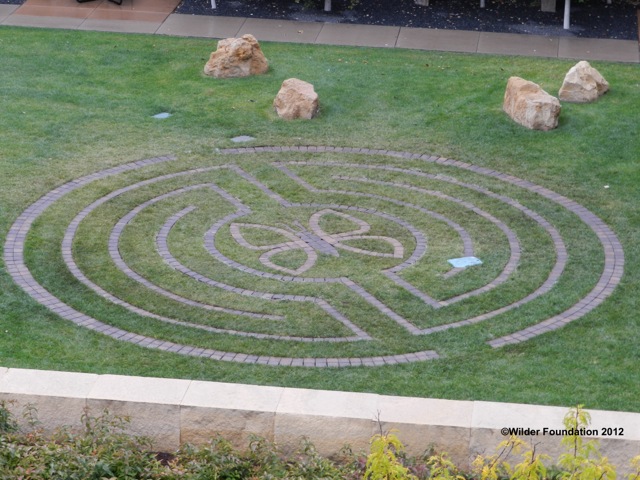
Wilder Foundation Labyrinth – The Amherst H. Wilder Foundation is a nonprofit community organization serving children, families and older adults in the east metro since 1906.
****************
The Story of the Snow Labyrinth: The Day I Met Marilyn Larson
In 1996, Tim and I moved to Northfield. That fall, we enjoyed walking the large labyrinth at the Carleton arboretum, and in November of that year I met Marilyn Larson. We were brought together by mutual acquaintances who kept urging us to connect. The day we finally had tea was a magical one. The first snowfall started. Marilyn shared that she was planning to walk the Carleton labyrinth (the first one she had fashioned), since on that day the star cluster of the Seven Sisters—the Pleiades—would be overhead at midnight. According to the Hopi tradition, this meant that the story telling season had begun.
Now, I am not a night owl, but I agreed to meet Marilyn at her place at 11:45 p.m. It had snowed more than a foot during the intervening hours. We knew that the labyrinth path would be covered over, but it was such a beautiful night we decided to walk over anyway. As we approached the large expanse of field at the foot of the Hill of Three Oaks, indeed, we saw an unbroken field of new-fallen snow. Marilyn, who had walked the gigantic labyrinth, with seven circuits and a diameter of 93 feet dozens of times, stopped.
“This is the gateway,” she said.
“I bet you could walk it by memory,” I said.
Marilyn started walking, breaking a path in the snow. I followed close behind, keeping my eyes on the back of her parka. It took a long time. When we got to the center, Marilyn stopped. We both turned and there, spread out on the slope of the hill was the perfect outline of a flawless form, a combination of labyrinth and snow angel. It was perfectly quiet. After a time, I took out a small votive candle made of beeswax and lit it, then placed it in the center, sheltering it in a nest of new snow. Heavy clouds obscured the sky, but we knew that above them the stars were overhead. After a few moments of quiet, we left the center, retracing our steps, leaving the candle to burn out like a fallen star.
The next morning, I returned. I was fairly certain that romping dogs or cross-country skiers had distorted the pattern…but no! It was just as it had been the evening before, down to the tiny flame flickering at its heart.
Other News
For more photos and information on the Hennepin County Medical Center labyrinth, please click on this link: http://www.hcmc.org/services Then click on “Spiritual Care” to find more photos and information.
You can rent a canvas labyrinth designed and painted by Marilyn Larson through www.wisdomwayscenter.org. A Pocket Guide to Labyrinths is available at the Hennepin County Medical Center gift shop, the Carondelet Center in St. Paul, Minnesota (www.carondeletcenter.org), Grace Cathedral in San Francisco, California (http://theshop.gracecathedral.org/Labyrinth_Items), and from Marilyn Larson.
Readers interested commissioning a labyrinth or purchasing original art work can reach her at:
Marilyn Larson
P.O. Box 2610
Minneapolis, MN 55402

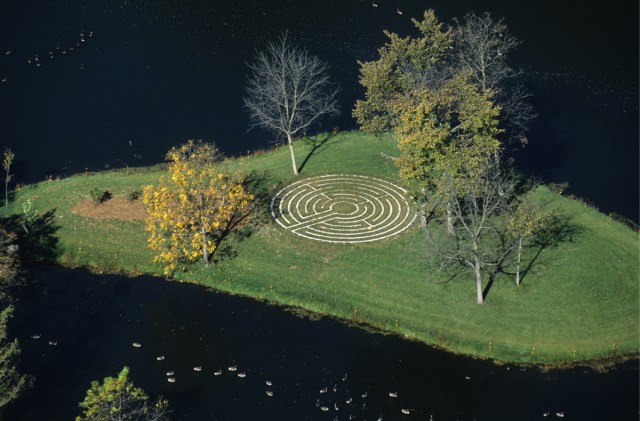
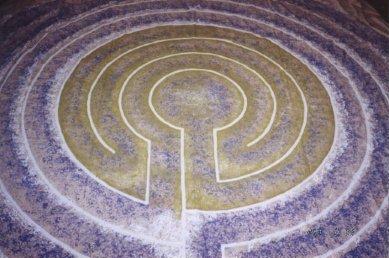
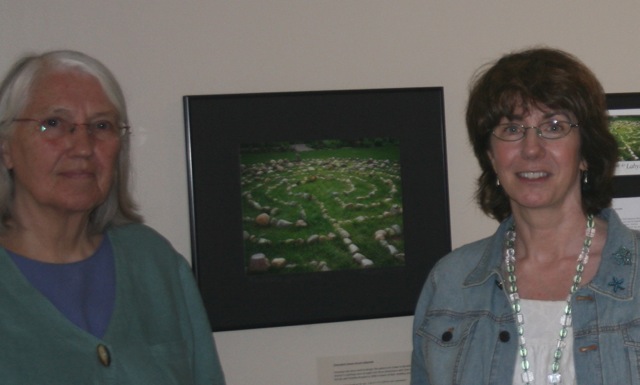
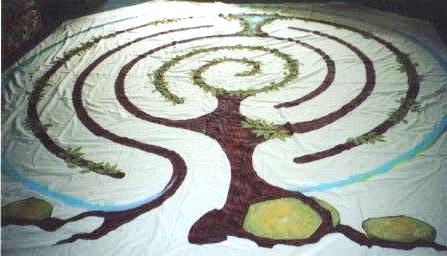

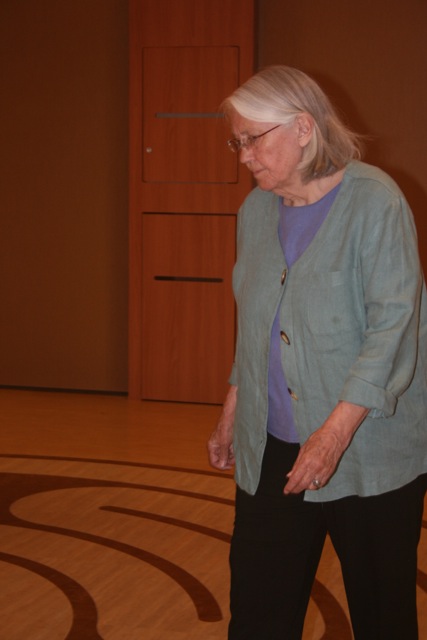
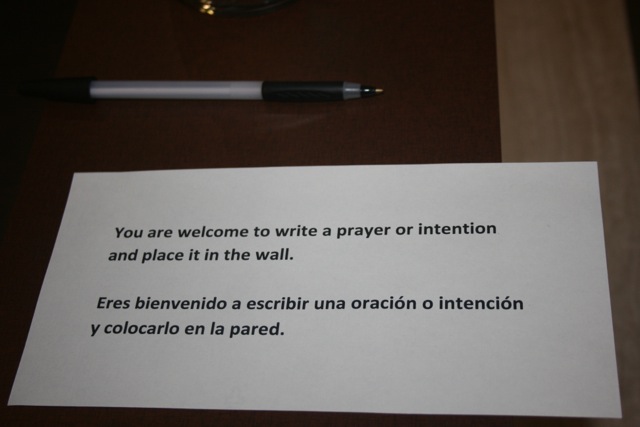

I regret we didn’t get to walk the labyrinth at Carlton when I was there last year. I’d love to pay a return visit when I’m not so miserably ill. Maybe next year.